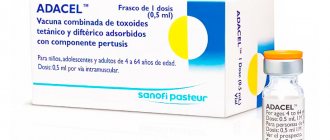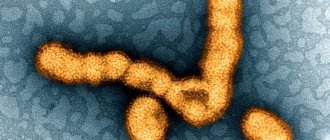Vaccine options
Vaccines against pneumococcal infection began to be developed only in the second half of the 20th century.
The difficulty in creating such vaccinations was (and is) the huge number of types of pneumococcus - more than 90 in total. First, a 14-valent vaccine was created. It began to be used in 1977. And in 1981 it was replaced by a 23-valent vaccine, which is still used today. But these vaccinations against pneumococcal infection could only be used by children from the age of two. And the most vulnerable group of young children still remained unprotected from pneumococci. Therefore, pharmaceutical companies around the world have begun developing a new generation of drugs - conjugate vaccines. The first such vaccine was the seven-valent pneumococcal conjugate vaccine Prevenar. It included seven types of pneumococcus, each of which was conjugated with non-toxic diphtheria protein and adsorbed on aluminum phosphate. The following vaccinations are currently used in Russia: Pneumo-23 (non-conjugated polysaccharide vaccine), 13-valent Prevenar 13, 10-valent Synflorix. Prevenar vaccinations can be administered to all children from 2 months of age, 10-valent Synflorix (polysaccharide, conjugated with D-protein of non-typeable Haemophilus influenzae, tetanus and diphtheria toxoids, adsorbed) - from 6 weeks and Pneumo-23 vaccination "- only from 2 years old.
Who is at risk?
- children with immunodeficiencies;
- children with chronic lung diseases, including asthma;
- children with chronic diseases of the cardiovascular system, liver and kidneys;
- children with diabetes;
- children with a removed spleen;
- children who have received or are planning to undergo organ and tissue transplantation.
What is included in the pneumococcal vaccine?
1. The conjugate vaccine (Prevenar 13) includes:
- polysaccharides (parts of the cell wall) of 13 types of pneumococcal bacteria,
- aluminum phosphate as an adjuvant (a substance that enhances the immune response to vaccination),
- polysorbate 80 as a stabilizer (a substance that helps maintain the homogeneity of the solution),
- succinic acid as a preservative,
- sodium chloride as a diluent.
3. The 10-valent vaccine (Synflorix) contains, in addition to 10 types of pneumococcal polysaccharides, carrier proteins (diphtheria and tetanus toxoid and Haemophilus influenzae protein). Thus, this vaccine may provide some protection against diphtheria, tetanus and Hib disease, but is not a substitute for routine vaccination against these infections.
3. The composition of the polysaccharide vaccine includes:
- parts of the cell wall of 23 types of pneumococcus,
- phenol as a preservative,
- sodium chloride as a diluent.
Principles and purposes of vaccination
Pneumococcal disease is one of the leading causes of morbidity and mortality worldwide. Serious diseases often caused by pneumococci include pneumonia, meningitis, and bacteremia with fever. In 2005, WHO estimated that 1.6 million people die each year from pneumococcal disease. Therefore it must be prevented.
By the end of 2013, pneumococcal vaccination had been introduced in 103 countries, and immunization coverage had reached 25%. By order of the Ministry of Health of the Russian Federation No. 125 of March 21, 2014, vaccination against pneumococcal infection was introduced into the National Calendar of Preventive Vaccinations of the Russian Federation.
Scheme of implementation
The maximum concentration of antibodies to pneumococcal infection occurs 3 months after administration of the vaccine and then slowly decreases over 5 years. To provide infants with maximum protection against the most common infectious diseases, children up to one year old are vaccinated against pneumococcal infection. Revaccination strengthens the immune response, therefore in Russia the following vaccination periods have been established: 2, 4.5 and 15 months. They were included in the National Calendar of Preventive Vaccinations of the Russian Federation in 2014.
Depending on the child’s health status, adjustments may be made to the vaccination schedule. If there was a severe allergic reaction during the first administration of the vaccine, this must be reported before the vaccination is repeated. For children under 2 years of age, the vaccine is injected into the thigh, and for older children, into the deltoid muscle. For parents of infants, any mandatory vaccinations raise many questions and concerns. Experts will help dispel all doubts.
Vaccine effectiveness
In international practice, since 2000, vaccination has been used for immunoprophylaxis of pneumococcal infection in newborns and young children. According to WHO, world experience has shown that mass vaccination reduces the incidence of pneumococcal meningitis and severe pneumonia in children by more than 80% and the incidence of all pneumonia and otitis media by more than a third. The carriage of pneumococci in children is decreasing, and accordingly, both unvaccinated children and adults get sick less.
The World Health Organization projects that global use of pneumococcal vaccinations will prevent 5.4-7.7 million child deaths by 2030. The Prevenar13 vaccine protects against the thirteen most common types of pneumococcus, which cause up to 80% of pneumococcal infections.
Where to get a flu shot
— Where can I get a flu shot today?
— We have already received the Sovigripp vaccine. You can get vaccinated in clinics in vaccination rooms on a first-come, first-served basis. Traditionally, we carry out vaccinations by visiting enterprises, if managers approach us with such a request - these are already established connections. The question now being discussed is whether we will be able to vaccinate against influenza at our vaccination points in large shopping centers, where we are now vaccinating against coronavirus infection. In addition, in the fall we have a mobile first aid station, where we vaccinated against the flu. There are no contraindications or prohibitions against vaccination against different infections in the same office. We can vaccinate in our offices simultaneously during the day against hepatitis, diphtheria, influenza, pneumococcal infection, and coronavirus. Before the mass flu vaccination, we are now discussing how best to do it so as not to mix the flow, so that it is convenient for people, so that there is no feeling of fear or apprehension that they are being vaccinated against different infections at once, and whether there will be any risks of getting sick. Any vaccination, even just a trip to the clinic - the shorter the queue, the fewer risk factors for transmission of infection.
— Don’t you need to sign up for a flu shot? Can I just come to the clinic and get it done right away?
- Yes, we are doing this, because we are just now starting vaccination. There is no such excessive excitement. Based on the experience of past years, we managed because we are bringing as many medical workers as needed. Maybe we'll schedule a pre-registration. Flu vaccination is an already established technique; patients do not fill out a questionnaire; we collect it from the patient’s words from medical workers, and there is information about consent. Organized vaccination is always better than spontaneous vaccination. We will clarify how best to do it, we will be glad if we receive constructive suggestions from patients. We still focus on vaccination in organized teams - we go to enterprises so that the unemployed population remains in the clinic.
— Regarding flu vaccination in schools. Do you have this information: will our children be vaccinated?
— Seasonal flu vaccinations for children are carried out by children's clinics in schools and kindergartens. It starts at the beginning of the new school year, vaccinations are carried out en masse, actively, in order to achieve good immunity by the time the incidence begins to rise. Forecasts depend on the weather; if the autumn is warm enough, the rise in infection will shift to October - November. Always with the beginning of the school year, with the return of parents and adults from vacation, there is migration within the city, so the risk of spreading infections is higher, so the use of masks to prevent coronavirus infection and influenza remains relevant. If we go back to pre-Covid times, medical organizations and other organizations always introduced a mask regime and certain restrictive quarantine measures when there was an increase in the incidence rate and the risk of the spread of influenza. Now we are all accustomed to them, although we are already tired of them, we all want a free life, as people say, but restrictive measures - social distance, wearing masks, gloves - are general principles of prevention with all respiratory infections.
— I look at the weather forecast in the near future with caution - the temperature will drop significantly, although not for long, for a week, but there will still be rain and cold weather. Is it worth protecting yourself?
“On the other hand, I hope that a good hot summer has boosted our immune systems a little and gained strength, including for protection. In the fall, we recommend taking care of yourself, dressing according to the weather, using nonspecific prevention - vitamin therapy, warm drinks, trying to avoid hypothermia, and trying to see a doctor. Now the coronavirus infection is already masked, manifesting itself as a banal acute respiratory infection, maybe like the beginning of the flu. In practice, it is difficult to differentiate Covid, so we take swabs for coronavirus infection from all patients, of any age, with minimal manifestations of respiratory diseases. The diagnosis of “flu” is also confirmed by smears.
— Do we have any hope that if someone gets sick with respiratory diseases, we will be tested and found out whether it is the flu or coronavirus?
— There will definitely be swabs taken for the virus, and the situation regarding the flu is being monitored. We currently have no cases of influenza. And there are no flu packages. It can arise somewhere out there, so we urge you to get vaccinated now so that you already have immunity. And as soon as there is a risk or information that patients with influenza are appearing, then we take swabs for influenza, but from a certain category of symptomatic citizens.
Contraindications
For pneumococcal conjugate vaccines: increased sensitivity to previous vaccination (severe generalized allergic reactions); hypersensitivity to diphtheria toxoid and/or excipients; acute infectious or non-infectious diseases, exacerbations of chronic diseases. Vaccinations against pneumococcal infection are carried out after recovery or during remission. Pneumococcal polysaccharide vaccines: pronounced reaction to the previous vaccination, PPV23 vaccination less than 3 years before the intended PPV23 vaccination.
Can the pneumococcal vaccine protect against Covid?
In late summer and fall 2021, reports emerged that the pneumococcal vaccine could protect against Covid-19 infection. Actually, no—it only prevents pneumococcal infections. On the other hand, many scientists and doctors believe that the pneumococcal vaccine can protect the patient from secondary complications of coronavirus infection.
In any case, vaccination against other respiratory diseases is still highly recommended during the Covid-19 pandemic.
There are no complications after vaccination with Prevenar. The patient may experience increased temperature and redness at the injection site. However, such a reaction usually occurs in people who have already had pneumococcus.
To get vaccinated, please make an appointment with our vaccination doctor by phone or online chat on the website.
When to vaccinate?
The following administration schedules are available for pneumococcal conjugate vaccines:
| Start of vaccination | PCV10 vaccination | PCV13 vaccination |
| 2-6 months | 3 times with an interval of at least 1 month and revaccination in the 2nd year (at 12-15 months) or 2 times with an interval of at least 2 months and revaccination in the 2nd year (15 months) | 3 times with an interval of at least 1 month and revaccination in the 2nd year (at 12-15 months) or 2 times with an interval of at least 2 months and revaccination at 15 months |
| 7-11 months | 2 times with an interval of at least 1 month and revaccination in the 2nd year of life | 2 times with an interval of at least 1 month and revaccination in the 2nd year of life |
| 12-23 months | 2 times with an interval of at least 2 months | 2 times with an interval of at least 2 months |
| 2-5 years (24-71 months) | One time |
For children at risk, there is a booster vaccination scheme with polysaccharide pneumococcal vaccine (PPV23) no earlier than 2 months after PCV administration.
It is recommended to begin immunization of adults with PCV13 vaccination to form immune memory and increase the duration of possible protection against pneumococci. A similar booster vaccination with PPV23 in adults is carried out no earlier than 12 months after the introduction of PCV.
Features of vaccinations against pneumonia
Microorganisms that cause pneumonia have serotypes of varying degrees of pathogenicity (about 100 species). About a quarter of them are constantly transmitted to humans. The preparations contain antigens of bacteria of the most common serotypes.
The most famous vaccines against pneumonia
Prevenar (USA)
— polysaccharide-protein pneumococcal vaccine, provides immunity to 13 main types of pathogens, recommended for use in infants from the age of two months. The vaccine has a preventive effect and prevents the development of a number of diseases.
Pneumo-23 (France)
— the vaccine protects against pneumococci of 23 serotypes and is approved for children over two years of age. Lasting immunity for 5 years is achieved with just one dose.
Contains Synflorix
(developed by Belgian scientists) ten most common bacterial antigens. These types of streptococcus are responsible for 50 to 95% of pneumococcal cases in children under 5 years of age. In addition to streptococcus, the vaccine against pneumonia forms immunity to Haemophilus influenzae) and enhances the development of immunity to the administration of diphtheria and tetanus toxoids.
Vaccines are administered intramuscularly and subcutaneously. Immunization against pneumococci can be combined with routine vaccinations.
Vaccination scheme
In accordance with the National Vaccination Calendar, vaccination against pneumonia is carried out at 2, 4, 5 and 15 months. If a child has not been vaccinated before the age of two, it can be vaccinated at 5-6 years of age. This is especially important for children who are often sick.
The site of vaccine administration for children under 2 years of age is the anterolateral surface of the thigh. For older people, the injection is performed in the upper third of the shoulder.
Vaccination against pneumonia in adults is carried out once, revaccination is not required. NEARMEDIC doctors recommend that adults at risk get vaccinated regularly, every 5 years.
Possible adverse reactions
Modern drugs rarely have side effects. As a rule, this is redness and soreness at the injection site, and slight swelling is possible. Sometimes the temperature may rise slightly and appetite may decrease. In the vast majority of cases, these manifestations pass quickly.
Contraindications
- Individual intolerance to the drug;
- Allergy to vaccine components;
- Fever;
- Acute diseases;
- Chronic progressive diseases.
The last three indications are not absolute - vaccination is postponed to a later date when the child recovers or enters the remission stage for chronic diseases.









